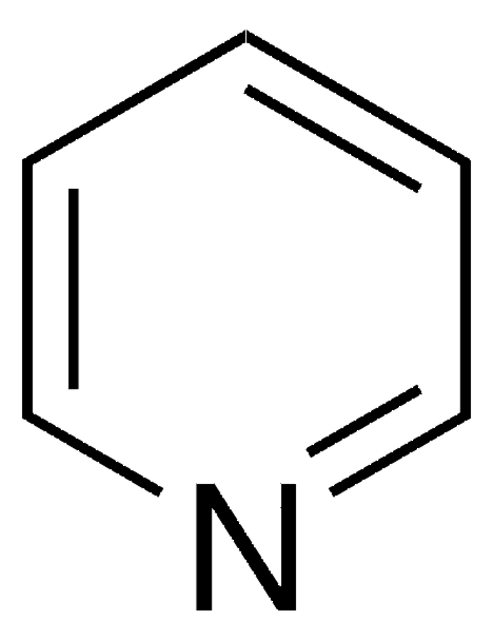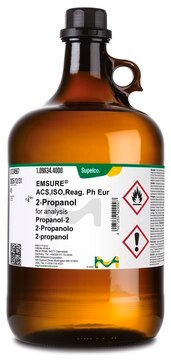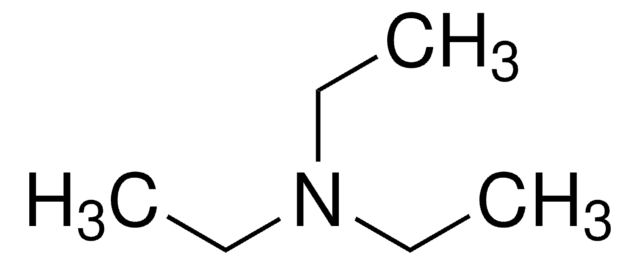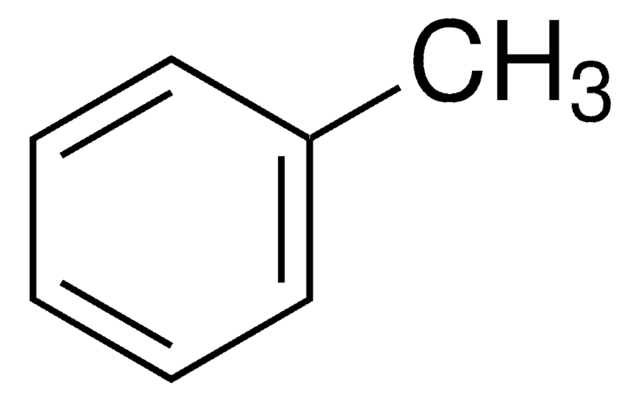360570
Pyridin
ACS reagent, ≥99.0%
About This Item
Empfohlene Produkte
Qualität
ACS reagent
Qualitätsniveau
Dampfdichte
2.72 (vs air)
Dampfdruck
10 mmHg ( 13.2 °C)
20 mmHg ( 25 °C)
Assay
≥99.0%
Form
liquid
Selbstzündungstemp.
899 °F
Expl.-Gr.
12.4 %
Verunreinigungen
Reducing substances, passes test
≤0.002% NH3
0.1% water
Abdampfrückstand
≤0.002%
Brechungsindex
n20/D 1.509 (lit.)
pH-Wert
8.5 (25 °C, 15.82 g/L)
bp
115 °C (lit.)
mp (Schmelzpunkt)
−42 °C (lit.)
Löslichkeit
water: soluble
Dichte
0.978 g/mL at 25 °C (lit.)
Anionenspuren
chloride (Cl-): ≤0.001%
sulfate (SO42-): ≤0.001%
Kationenspuren
Cu: ≤5 ppm
SMILES String
C1=CN=CC=C1
InChI
1S/C5H5N/c1-2-4-6-5-3-1/h1-5H
InChIKey
JUJWROOIHBZHMG-UHFFFAOYSA-N
Suchen Sie nach ähnlichen Produkten? Aufrufen Leitfaden zum Produktvergleich
Verwandte Kategorien
Allgemeine Beschreibung
Anwendung
- complexes with cobalt(II) halides
- pyridine-d5, a deuterated form of pyridine
- ionic liquid matrices (ILMs)
Verpackung
Signalwort
Danger
Gefahreneinstufungen
Acute Tox. 4 Dermal - Acute Tox. 4 Inhalation - Acute Tox. 4 Oral - Eye Irrit. 2 - Flam. Liq. 2 - Skin Irrit. 2
Lagerklassenschlüssel
3 - Flammable liquids
WGK
WGK 2
Flammpunkt (°F)
68.0 °F - closed cup
Flammpunkt (°C)
20 °C - closed cup
Analysenzertifikate (COA)
Suchen Sie nach Analysenzertifikate (COA), indem Sie die Lot-/Chargennummer des Produkts eingeben. Lot- und Chargennummern sind auf dem Produktetikett hinter den Wörtern ‘Lot’ oder ‘Batch’ (Lot oder Charge) zu finden.
Besitzen Sie dieses Produkt bereits?
In der Dokumentenbibliothek finden Sie die Dokumentation zu den Produkten, die Sie kürzlich erworben haben.
Unser Team von Wissenschaftlern verfügt über Erfahrung in allen Forschungsbereichen einschließlich Life Science, Materialwissenschaften, chemischer Synthese, Chromatographie, Analytik und vielen mehr..
Setzen Sie sich mit dem technischen Dienst in Verbindung.




